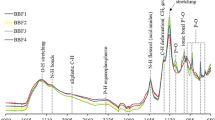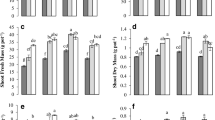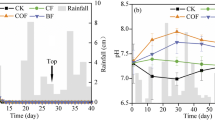Abstract
The aim of this study was to assess the effects of a biochar-based slow-release P fertilizer (BBSRPF) produced from a corn stover-derived biochar (CSB), compared to mineral fertilization and co-application of CSB itself and mineral fertilization on bioavailability of soil P and spinach production, as well as, foliar macronutrients (N, P and K), protein, and ascorbic acid in plants.
First, CSB was produced from corn stover. Then, P loading process was done with a KH2PO4 solution for BBSRPF production. Afterwards, a greenhouse experiment was performed for 70 days using a factorial design with the following treatments: mineral NPK fertilization (F), CSB and mineral NPK fertilization (BC) and BBSRPF and mineral NK fertilization (P-BC). After this, soil samples were collected and the plants were harvested to determine changes in soil physicochemical properties, bioavailability of soil P, leaf content of P, N, K, ascorbic acid, and protein. Besides, fresh and dry biomass, and crop yield were also determined.
The P-BC treatment significantly increased bioavailable soil P by ~ 72% compared to F and BC treatments. Furthermore, P, N, K, protein, ascorbic acid content, and yield of spinach pants were significantly increased by ~ 29, 52, 33, 20, 21, and ~ 25% when P-BC treatment was applied, respectively.
Incorporation of P into the biochar matrix is an effective strategy to increase spinach P use efficiency in tropical soils. Therefore, BBSRPF could totally replace conventional mineral P fertilizers without compromising crop yield, and increasing the nutritional quality of spinach plants.






Similar content being viewed by others
Data Availability
The datasets generated during the current study are available from the corresponding author on reasonable request.
Code Availability
Not applicable.
References
Ahmad M, Usman ARA, Al-Faraj AS, Ahmad M, Sallam A, Al-Wabel MI (2018) Phosphorus-loaded biochar changes soil heavy metals availability and uptake potential of maize (Zea mays L.) plants. Chemosphere 194:327–339. https://doi.org/10.1016/j.chemosphere.2017.11.156
Aiking H (2011) Future protein supply. Trends Food Sci Technol 22:112–120. https://doi.org/10.1016/J.TIFS.2010.04.005
Bashir S, Hussain Q, Shaaban M, Hu H (2018) Efficiency and surface characterization of different plant derived biochar for cadmium (Cd) mobility, bioaccessibility and bioavailability to Chinese cabbage in highly contaminated soil. Chemosphere 211:632–639. https://doi.org/10.1016/j.chemosphere.2018.07.168
Bergquist SÅM, Gertsson UE, Olsson ME (2006) Influence of growth stage and postharvest storage on ascorbic acid and carotenoid content and visual quality of baby spinach (Spinacia oleracea L.). J Sci Food Agric 86:346–355. https://doi.org/10.1002/jsfa.2373
Bojacá CR, Wyckhuys KAG, Gil R, Jiménez J, Schrevens E (2010) Sustainability aspects of vegetable production in the peri-urban environment of Bogotá, Colombia. Int J Sustain Dev World Ecol 17:487–498. https://doi.org/10.1080/13504509.2010.516890
Bolan NS, Adriano DC, Curtin D (2003) Soil acidification and liming interactions with nutrientand heavy metal transformationand bioavailability. Adv Agron 78:215–272
Bouwman L, Goldewijk KK, Van Der Hoek KW, Beusen AHW, Van Vuuren DP, Willems J, Rufino MC, Stehfest E (2013) Exploring global changes in nitrogen and phosphorus cycles in agriculture induced by livestock production over the 1900–2050 period. Proc Natl Acad Sci U S A 110:20882–20887. https://doi.org/10.1073/pnas.1012878108
Bradford M (1976) A Rapid and Sensitive Method for the Quantitation of Microgram Quantities of Protein Utilizing the Principle of Protein-Dye Binding. Anal Biochem 72:248–254. https://doi.org/10.1006/abio.1976.9999
Carvalho FAL, Pateiro M, Domínguez R, Barba-Orellana S, Mattar J, Rimac Brnčić S, Barba FJ, Lorenzo JM (2019) Replacement of meat by spinach on physicochemical and nutritional properties of chicken burgers. J Food Process Preserv 43:e13935. https://doi.org/10.1111/jfpp.13935
Casierra-Posada F, Briceño-Pinzón ID, Carreño-Patiño JA (2021) Tolerance of Spinach ( Spinacia oleracea ) Plants to Partial Defoliation. Gesunde Pflanz 2021:1–8. https://doi.org/10.1007/S10343-021-00561-7
Chew J, Zhu L, Nielsen S et al (2020) Biochar-based fertilizer: Supercharging root membrane potential and biomass yield of rice. Sci Total Environ 713:136431. https://doi.org/10.1016/j.scitotenv.2019.136431
Chintala R, Schumacher TE, McDonald LM, Clay DE, Malo DD, Papiernik SK, Clay SA, Julson JL (2014) Phosphorus Sorption and Availability from Biochars and Soil/Biochar Mixtures. CLEAN - Soil, Air, Water 42:626–634. https://doi.org/10.1002/clen.201300089
Citak S, Sonmez S (2010) Effects of conventional and organic fertilization on spinach (Spinacea oleracea L.) growth, yield, vitamin C and nitrate concentration during two successive seasons. Sci Hortic (amsterdam) 126:415–420. https://doi.org/10.1016/j.scienta.2010.08.010
Coates J (2006) Interpretation of Infrared Spectra, A Practical Approach. Encyclopedia of Analytical Chemistry. John Wiley & Sons Ltd, Chichester
da Carneiro JS, S, Ribeiro ICA, Nardis BO, Barbosa CF, Lustosa Filho JF, Melo LCA, (2021) Long-term effect of biochar-based fertilizers application in tropical soil: Agronomic efficiency and phosphorus availability. Sci Total Environ 760:143955. https://doi.org/10.1016/J.SCITOTENV.2020.143955
Eduah JO, Nartey EK, Abekoe MK, Breuning-Madsen H, Andersen MN (2019) Phosphorus retention and availability in three contrasting soils amended with rice husk and corn cob biochar at varying pyrolysis temperatures. Geoderma 341:10–17. https://doi.org/10.1016/j.geoderma.2019.01.016
Fan D, Kandasamy S, Hodges DM, Critchley AT, Prithiviraj B (2014) Pre-harvest treatment of spinach with Ascophyllum nodosum extract improves post-harvest storage and quality. Sci Hortic (amsterdam) 170:70–74. https://doi.org/10.1016/j.scienta.2014.02.038
Gallego JL, Olivero-Verbel J (2021) Cytogenetic toxicity from pesticide and trace element mixtures in soils used for conventional and organic crops of Allium cepa L. Environ Pollut 276:116558. https://doi.org/10.1016/j.envpol.2021.116558
Gallie DR (2013) L-Ascorbic Acid: A Multifunctional Molecule Supporting Plant Growth and Development. Scientifica (Cairo) 2013:735964. https://doi.org/10.1155/2013/795964
Hedley MJ, Stewart JWB, Chauhan BS (1982) Changes in Inorganic and Organic Soil Phosphorus Fractions Induced by Cultivation Practices and by Laboratory Incubations. Soil Sci Soc Am J 46:970–976. https://doi.org/10.2136/sssaj1982.03615995004600050017x
Jung KW, Jeong TU, Kang HJ, Ahn KH (2016) Characteristics of biochar derived from marine macroalgae and fabrication of granular biochar by entrapment in calcium-alginate beads for phosphate removal from aqueous solution. Bioresour Technol 211:108–116. https://doi.org/10.1016/j.biortech.2016.03.066
Keller T, Schwager H (1977) Air pollution and ascorbic acid. For Pathol 7:338–350. https://doi.org/10.1111/j.1439-0329.1977.tb00603.x
Khan WD, Ramzani PMA, Anjum S, Abbas F, Iqbal M, Yasar A, Ihsan MZ, Anwar MN, Baqar M, Tauqeer HM, Virk ZA, Khan SA (2017) Potential of miscanthus biochar to improve sandy soil health, in situ nickel immobilization in soil and nutritional quality of spinach. Chemosphere 185:1144–1156. https://doi.org/10.1016/j.chemosphere.2017.07.097
Klammsteiner T, Turan V, Juárez MF-D, Oberegger S, Insam H (2020) Suitability of Black Soldier Fly Frass as Soil Amendment and Implication for Organic Waste Hygienization. Agron 1578:10–1578. https://doi.org/10.3390/AGRONOMY10101578
Lander EM, Wertheim BC, Koch SM, Chen Z, Hsu CH, Thomson CA (2016) Vegetable protein intake is associated with lower gallbladder disease risk: Findings from the Women’s Health Initiative prospective cohort. Prev Med (baltim) 88:20–26. https://doi.org/10.1016/j.ypmed.2016.03.016
Lara OA, Amorós A, Tapia ML, Escalona VH (2021) Effect of a photoselective filter on the yield and postharvest quality of “Viroflay” baby spinach (Spinacia oleracea L.) leaves cultivated in a hydroponic system. Sci Hortic (amsterdam) 277:109804. https://doi.org/10.1016/J.SCIENTA.2020.109804
Li ZF, Wang Q, Zhang WJ, Du ZL, He XH, Zhang QZ (2016) Contributions of Nutrients in Biochar to Increase Spinach Production: A Pot Experiment. Commun Soil Sci Plant Anal 47:2003–2007. https://doi.org/10.1080/00103624.2016.1225078
Li H, Li Y, Xu Y, Lu X (2020) Biochar phosphorus fertilizer effects on soil phosphorus availability. Chemosphere 244:125471. https://doi.org/10.1016/j.chemosphere.2019.125471
Lin W, Lin M, Zhou H, Wu H, Li Z, Lin W (2019) The effects of chemical and organic fertilizer usage on rhizosphere soil in tea orchards. PLoS ONE 14:0217018. https://doi.org/10.1371/journal.pone.0217018
López JE, Builes S, Heredia Salgado MA, Tarelho LAC, Arroyave C, Aristizábal A, Chavez E (2020a) Adsorption of Cadmium Using Biochars Produced from Agro-Residues. J Phys Chem C 124:14592–14602. https://doi.org/10.1021/acs.jpcc.0c02216
López JE, Gallego JL, Vargas-Ruiz A, Peña-Mosquera AL, Zapata-Zapata AD, López-Sánchez IJ, Botero-Botero LR (2020b) Aspergillus tubingensis and Talaromyces islandicus Solubilize Rock Phosphate Under Saline and Fungicide Stress and Improve Zea mays Growth and Phosphorus Nutrition. J Soil Sci Plant Nutr 20:2490–2501. https://doi.org/10.1007/s42729-020-00315-w
Lustosa Filho JF, da Carneiro JS, Barbosa CF, de Lima KP, Leite do A, Melo LCA (2020) Aging of biochar-based fertilizers in soil: Effects on phosphorus pools and availability to Urochloa brizantha grass. Sci Total Environ 709:136028. https://doi.org/10.1016/J.SCITOTENV.2019.136028
Marti-Quijal FJ, Zamuz S, Tomašević I, Gómez B, Rocchetti G, Lucini L, Remize F, Barba FJ, Lorenzo JM (2019) Influence of different sources of vegetable, whey and microalgae proteins on the physicochemical properties and amino acid profile of fresh pork sausages. LWT 110:316–323. https://doi.org/10.1016/j.lwt.2019.04.097
Mozafar A (1993) Nitrogen fertilizers and the amount of vitamins in plants: A review. J Plant Nutr 16:2479–2506
Muñoz Romero JH, Sepúlveda Cadavid CA, Cortés N, López Correa JE, Correa Estrada JD (2019) Inactivation of Fusarium oxysporum Conidia in Soil with Gaseous Ozone-Preliminary Studies. Ozone Sci Eng 42:36–42. https://doi.org/10.1080/01919512.2019.1608810
Naeem I, Masood N, Turan V, Iqbal M (2021) Prospective usage of magnesium potassium phosphate cement combined with Bougainvillea alba derived biochar to reduce Pb bioavailability in soil and its uptake by Spinacia oleracea L. Ecotoxicol Environ Saf 208:111723. https://doi.org/10.1016/J.ECOENV.2020.111723
Nardis BO, da Silva S, Carneiro J, de Souza IMG, de Barros RG, Azevedo Melo LC (2020) Phosphorus recovery using magnesium-enriched biochar and its potential use as fertilizer. Arch Agron Soil Sci 03650340(2020):1771699. https://doi.org/10.1080/03650340.2020.1771699
Novais SV, Zenero MDO, Tronto J, Conz RF, Cerri CEP (2018) Poultry manure and sugarcane straw biochars modified with MgCl2 for phosphorus adsorption. J Environ Manage 214:36–44. https://doi.org/10.1016/j.jenvman.2018.02.088
Pansu M, Gautheyrou J (2006) Handbook of Soil Analysis. Springer Berlin Heidelberg, Berlin
Pogorzelski D, Filho JFL, Matias PC, Santos WO, Vergütz L, Melo LCA (2020) Biochar as composite of phosphate fertilizer: Characterization and agronomic effectiveness. Sci Total Environ 743:140604. https://doi.org/10.1016/J.SCITOTENV.2020.140604
Roberts JL, Moreau R (2016) Functional properties of spinach (Spinacia oleracea L.) phytochemicals and bioactives. Food Funct 7:3337–3353
Sabaté J, Sranacharoenpong K, Harwatt H, Wien M, Soret S (2015) The environmental cost of protein food choices. Public Health Nutr 18:2067–2073. https://doi.org/10.1017/S1368980014002377
Salehi B, Tumer TB, Ozleyen A et al (2019) Plants of the genus Spinacia: From bioactive molecules to food and phytopharmacological applications. Trends Food Sci Technol 88:260–273
Shi R, Hong Z, Li J, Jiang J, Baquy MA-A, Xu R, Qian W (2017) Mechanisms for Increasing the pH Buffering Capacity of an Acidic Ultisol by Crop Residue-Derived Biochars. J Agric Food Chem 65:8111–8119. https://doi.org/10.1021/acs.jafc.7b02266
Shi RY, Ni N, Nkoh JN, Dong Y, Zhao WR, Pan XY, Li JY, Xu RK, Qian W (2020) Biochar retards Al toxicity to maize (Zea mays L.) during soil acidification: The effects and mechanisms. Sci Total Environ 719:137448. https://doi.org/10.1016/j.scitotenv.2020.137448
Turan V (2019) Confident performance of chitosan and pistachio shell biochar on reducing Ni bioavailability in soil and plant plus improved the soil enzymatic activities, antioxidant defense system and nutritional quality of lettuce. Ecotoxicol Environ Saf 183:109594. https://doi.org/10.1016/J.ECOENV.2019.109594
Turan V (2020) Potential of pistachio shell biochar and dicalcium phosphate combination to reduce Pb speciation in spinach, improved soil enzymatic activities, plant nutritional quality, and antioxidant defense system. Chemosphere 245:125611. https://doi.org/10.1016/j.chemosphere.2019.125611
Volf MR, Rosolem CA (2020) Soil P Diffusion and Availability Modified by Controlled-Release P Fertilizers. J Soil Sci Plant Nutr 21:162–172. https://doi.org/10.1007/s42729-020-00350-7
Wang J, Zhang Z, Huang R (2013) Regulation of ascorbic acid synthesis in plants. Plant Signal Behav 8:e24536
Xu G, Sun J, Shao H, Chang SX (2014) Biochar had effects on phosphorus sorption and desorption in three soils with differing acidity. Ecol Eng 62:54–60. https://doi.org/10.1016/j.ecoleng.2013.10.027
Yao Y, Gao B, Chen J, Yang L (2013) Engineered Biochar Reclaiming Phosphate from Aqueous Solutions: Mechanisms and Potential Application as a Slow-Release Fertilizer. Environ Sci Technol 47:8700–8708. https://doi.org/10.1021/ES4012977
Younis U, Malik SA, Rizwan M, Qayyum MF, Ok YS, Shah MHR, Rehman RA, Ahmad N (2016) Biochar enhances the cadmium tolerance in spinach (Spinacia oleracea) through modification of Cd uptake and physiological and biochemical attributes. Environ Sci Pollut Res 23:21385–21394. https://doi.org/10.1007/s11356-016-7344-3
Zhang H, Chen C, Gray EM, Boyd SE, Yang H, Zhang D (2016) Roles of biochar in improving phosphorus availability in soils: A phosphate adsorbent and a source of available phosphorus. Geoderma 276:1–6. https://doi.org/10.1016/j.geoderma.2016.04.020
Zhu J, Li M, Whelan M (2018) Phosphorus activators contribute to legacy phosphorus availability in agricultural soils: A review. Sci Total Environ 612:522–537. https://doi.org/10.1016/j.scitotenv.2017.08.095
Zubair M, Adnan Ramzani PM, Rasool B, Khan MA, ur-Rahman M, Akhtar I, Turan V, Tauqeer HM, Farhad M, Khan SA, Iqbal J, Iqbal M, (2021) Efficacy of chitosan-coated textile waste biochar applied to Cd-polluted soil for reducing Cd mobility in soil and its distribution in moringa (Moringa oleifera L.). J Environ Manage 284:112047. https://doi.org/10.1016/J.JENVMAN.2021.112047
Acknowledgements
The authors thank the laboratory of the Institución Universitaria Colegio Mayor de Antioquia for its technical support and Semillero de Investigación en Ciencias Ambientales—SICA. Furthermore, Julián E. López thanks Universidad de Medellín for the scholarship [No. 321316/427405].
Funding
This study was funded by Institución Universitaria Colegio Mayor de Antioquia and Universidad de Medellín.
Author information
Authors and Affiliations
Contributions
Maicol Torres and Evelyn Becerra-Agudelo: soil samples collection, methodology validation, assays development, data collection, data analysis, and writing the first draft of the paper.
Cindy Sepúlveda-Cadavid and Jhon H. Romero: conceptualization, experimental design, data analysis, review, and editing of the paper.
Julián E. López: conceptualization, funding acquisition, experimental design, data analysis, supervision, review, and editing of the paper.
Corresponding author
Ethics declarations
Conflict of Interest
The authors declare no competing interests.
Additional information
Publisher's Note
Springer Nature remains neutral with regard to jurisdictional claims in published maps and institutional affiliations.
Supplementary Information
Below is the link to the electronic supplementary material.
Rights and permissions
About this article
Cite this article
Sepúlveda-Cadavid, C., Romero, J., Torres, M. et al. Evaluation of a Biochar-Based Slow-Release P Fertilizer to Improve Spinacia oleracea P Use, Yield, and Nutritional Quality. J Soil Sci Plant Nutr 21, 2980–2992 (2021). https://doi.org/10.1007/s42729-021-00583-0
Received:
Accepted:
Published:
Issue Date:
DOI: https://doi.org/10.1007/s42729-021-00583-0




